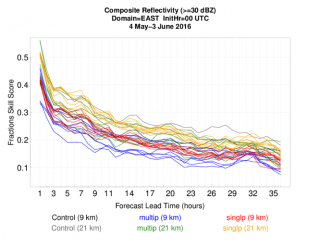
Multiscale and Probabilistic Prediction
Assessing merits of innovative NWP techniques for multiscale deterministic and probabilistic model guidance

Multiscale and Probabilistic Prediction
Assessing merits of innovative NWP techniques for multiscale deterministic and probabilistic model guidance

Multiscale and probabilistic prediction activities in the Joint Numerical Testbed program are focused primarily within the Developmental Testbed Center (DTC). The DTC is a distributed facility with components in the JNT at NCAR's Research Applications Laboratory (RAL), and the Global Systems Division (GSD) of NOAA's Earth System Research Laboratory (ESRL). It facilitates the transfer of research results into operations and provides the research community with an easily accessible state-of-the-art Numerical Weather Prediction (NWP) system for research. One of the DTC's focal points is regional forecasting systems, with a goal of accelerating the rate at which new technology is infused into operational weather forecasting.
NWP systems can generally be configured to suit a broad spectrum of weather regimes. The JNT conducts a variety of testing and evaluation (T&E) activities ranging from diagnostic case studies to extensive, seasonal or year-long experiments. While efforts continue related to evaluating deterministic model output, as operational centers move towards ensemble-based forecasting the JNT is becoming more involved in the T&E of probabilistic information. Emerging multi-scale global models are also an area of recent expansion and will continue to be a strong focus topic into the future.
The design for each T&E activity is created in consultation with the model developers, relevant area experts, and verification experts. Evaluation of these retrospective cases includes traditional verification approaches, as well as advanced verification techniques using the Model Evaluation Tools (MET). All verification statistics include a statistical significance (SS) and practical significance (PS) assessment when appropriate.
By conducting carefully controlled testing, including the generation of objective verification statistics, the JNT is able to provide the operational community with guidance for selecting new NWP technologies with potential value for operational implementation. In addition, the extensive testing provides the research community with baselines against which the impacts of new techniques can be evaluated. The statistical results also provide guidance to researchers in selecting model configurations to use for their projects.
In addition to extensive T&E through the DTC, the JNT is assisting the user community (especially students) with efficiently running NWP components and making connections with future collaborators through the establishment of software containers. Many times, the biggest hurdle when running a new software system is getting it set up and compiled on the intended computer platform. Building complex systems that require a number of external libraries can be a prohibitive hurdle for users to overcome. In order to reduce some of this difficulty, software containers are being exploited to ship complete software systems to users. The containers have everything that is needed to run a software application, including the necessary operating system components (tools and libraries) and compiled executable (or code and compiler), thus, allowing for the user to quickly produce output without being delayed by technical issues. DTC staff members created UPP and MET containers to supplement those containers that had already been established by others in the community (including, WPS, WRF, and NCL) so that an end-to-end NWP system can be fully employed through containers.
Contact
Jamie Wolff
Associate Scientist IV